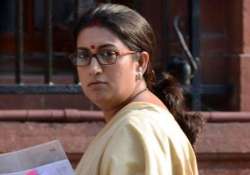Gross Enrollment Ratio (GER) in India 23.6 per cent: Smriti Irani
New Delhi: More youngsters in the age group of 18-23 years are acquiring higher education and the Gross Enrollment Ratio (GER) in India has risen to 23.6 per cent, and 46 per cent of those

New Delhi: More youngsters in the age group of 18-23 years are acquiring higher education and the Gross Enrollment Ratio (GER) in India has risen to 23.6 per cent, and 46 per cent of those enrolled are girls, a HRD ministry survey has found.
However, a gender disparity prevails in the number of teachers in higher education with merely 64 female teachers per 100 teachers, the All India Survey on Higher Education (AISHE) 2014-15 (provisional) has found.
Noticing this disparity, Human Resource Development (HRD) minister Smriti Irani, who unveiled the survey report today directed her ministry to formulate schemes so that the number of women teaching in higher education institutions can be increased.
Irani who, apart from the provisional findings for 2014-15, also released AISHE 2013-14 and launched the survey for 2015-16 also, indicated that she wanted the process of data collection to be made faster.
She said it is a "big challenge" from the point of view of data, that the report for year 2013-14 was being presented today.
A 60 day drive, she said, is being undertaken to ensure that data for 2015-16 can be expeditiously taken up in conjunction with states, institutes of higher learning in an attempt that before the next academic year, the data should be out.
Referring to the provisional data, Irani said it showed GER at 23.6 per cent which indicates that XII plan target of 30 per cent GER will be achieved. The data, she added, also shows that the women are taking to higher education in greater numbers as per the provisional data.
Among the other key findings of the AISHE 2014-15 (Provisional) are that the total enrollment in Higher Education is estimated to be 33.3 million with 17.9 million boys and 15.4 million girls.
The GER for male population is 24.5 per cent and for females is 22.7 percent. However, for Scheduled Castes the Gross Enrollment Ratio is 18.5 per cent while for Scheduled Tribes it is 13.3 per cent, which is lesser than the national average.
As per the survey, the Pupil Teacher Ratio in Universities and Colleges is 24.
Read Also: 63 students failed in IITs in last session: Smriti Irani
The provisional survey on Higher Education for 2014-15, found that the highest number of students are enrolled at Undergraduate level.
Out of the total 3,32,72,722 students, 79.9 per cent were found to be undergraduate students, the survey report said.
The survey also noted that 112812 students were enrolled in PhD that is about 0.34 per cent of the total enrollment.
States wise, UP had the highest number of students enrolled followed by Maharashtra and Tamil Nadu.
Scheduled Castes students constitute 13.4 per cent and Scheduled Tribes students 4.8 per cent of the total enrollment. 32.9 per cent students belong to Other Backward Classes, 4.4 per cent Muslims while 1.9 per cent were from other minority communities, as per the survey.
The AISHE (provisional) 2014-15 also found that distance enrollment constitutes 11.7 per cent of the total enrollment in higher education, of which 46 per cent are female students.
The Survey report said there are 757 Universities, 38,056 colleges and 11922 stand alone institutions and out of them 716 Universities, 29,506 colleges and 6,837 stand alone institutions have responded during the survey.
According to the AISHE for 2013-14, which too was released today, the GER was 23 per cent in that year.
The number of women teaching in higher education was marginally higher in that year, with 65 female teachers to every 100 males counterparts.
The AISHE 2013-14 also noted that the share of female students is lowest in Institutions of National Importance, followed by Deemed University (Government), State, Private Universities and Deemed University (Private).
UP has the highest number of colleges followed by Maharashtra and Karnataka while among districts Bangalore and Jaipur are ahead of others.
The survey for 2013-14 also found that top 50 districts have 35 per cent of the colleges.
College density in terms of number of colleges per lakh eligible ranged from 7 in Bihar to 60 in Puducherry with All
India average being 26.
As per the AISHE 2013-14, foreign students came from 158 countries from across the globe with highest number coming from Nepal.
It also found that there are more than 75 per cent colleges running in private sector which cater to only 65 per cent of the total enrollment.
The survey for 2013-14 also found that 56 per cent of colleges are in rural area while 10 per cent are exclusively for girls.